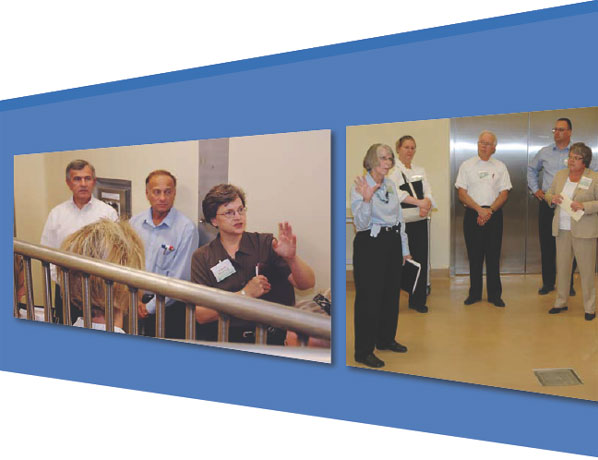USDA shows off a facility for research
A new building in Ames, Iowa, represents years of efforts to modernize key research facilities and to increase collaboration in the field of animal health.
On July 3, the U.S. Department of Agriculture dedicated a high-containment large animal facility in Ames that combines several research buildings. The new building is the second component of a multiple-phase, $460 million project to update and consolidate the USDA's National Animal Disease Center, National Veterinary Services Laboratories, and Center for Veterinary Biologics—which already share a common location.

Together, the three USDA units form the National Centers for Animal Health. The AVMA has advocated for the consolidation and modernization efforts since 1995. Last year, the Executive Board approved a policy to support sufficient operational funding for the new Ames facilities.
The newest facility
On hand during the dedication of the high-containment large animal facility were members of Iowa's congressional delegation, Secretary of Agriculture Mike Johanns, and the AVMA's 2006-2007 president and president-elect.

"It was very heartening to witness the completion of a state-of-the-art facility, which is now the gold standard in the world and creates so much potential for improving animal and human health," said Dr. Roger K. Mahr, then AVMA president.
The building will allow employees to work with a variety of endemic, zoonotic, and foreign animal diseases at biosafety level 3—agriculture. The facility features extensive air filtering and waste treatment. Construction lasted more than three years and cost about $85 million.
The 155,000-square-foot building will house cattle, bison, elk, deer, reindeer, sheep, and hogs. Employees who work in the new facility will conduct research, diagnostics, and training. They also will test vaccines and evaluate biological products.
Dr. Gregory S. Hammer, then AVMA president-elect, noted that the architects designed the facility with two sides to provide redundancy in case of a problem.
"What I was impressed with was the great pains that they took to make this facility so well-contained—the redundancy of seals and airlocks and water treatment and air treatment and negative pressures," Dr. Hammer said.
He added that the USDA employees in Ames badly need the new building.
"They are still working in buildings that are 50 years old, and those facilities are not the best that we could have or should have, especially given the potential we have for emerging disease problems," Dr. Hammer said.
Animal health
The first component of the Ames modernization project was a new laboratory, which the USDA completed in 2004. Another laboratory and a low-containment large animal facility are still under construction.
When the project concludes, the National Centers for Animal Health will feature about 1 million square feet of laboratory and research facilities. The USDA expects to finish by 2009.
Dr. Mahr said the collaboration among the National Animal Disease Center, National Veterinary Services Laboratories, and Center for Veterinary Biologics will benefit all three USDA units in areas such as emergency management.
"There will be enhanced animal health emergency preparedness and response, particularly the ability to train many more individuals capable of responding if needed," Dr. Mahr said.
Dr. Hammer said the AVMA and the rest of the Animal Agriculture Coalition lobbied Congress to fund the consolidation and modernization project.
"It was one of our lobbying efforts that we feel has been very successful," he said.
Dr. Hammer has visited the Ames complex previously, and he compared the historic configuration of the USDA units there to locating three colleges on one campus. He said bringing the units together will allow them to share information and become more efficient.
Public health
Dr. Mahr said the consolidation fits the one-health concept of a convergence of animal, human, and ecosystem health.
"Decreasing the risk and prevalence of current and emerging zoonotic diseases will be achieved through improved detection, diagnosis, and prevention, thereby decreasing exposure and transmission to humans," Dr. Mahr said.
He said expanding research on basic diseases of production animals will improve the availability of a safe and affordable food supply.
As the USDA completes modernization and consolidation of the National Centers for Animal Health, Dr. Mahr envisions further collaboration with centers for human health such as the Centers for Disease Control and Prevention and the National Institutes of Health.
Dr. Hammer said improvements to the Ames complex will protect public health by accelerating response to emerging diseases and other threats.
When he visited the high-containment large animal facility in July, Dr. Hammer kept thinking about the need for more veterinarians in biomedical research.
"We lobbied to get the building," Dr. Hammer said. "Now we have to lobby to get the people to put in it."
He said passage of the Veterinary Public Health Workforce Expansion Act could help educate veterinarians to work at the National Centers for Animal Health.